Orson Welles
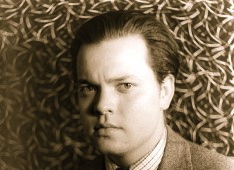
Orson Welles “Mysteries & Scandals” Produced by Dan Abrams
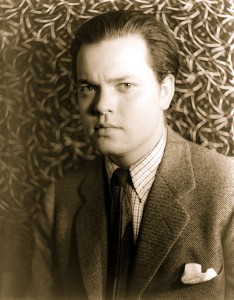 Welles on March 1, 1937 (age 21), photographed by Carl Van Vechten
Welles on March 1, 1937 (age 21), photographed by Carl Van Vechten
George Orson Welles (/ˈwɛlz/; May 6, 1915 – October 10, 1985) was an American actor, director, writer, and producer who worked in theatre, radio, and film. He is best remembered for his innovative work in all three media: in theatre, most notably Caesar (1937), a groundbreaking Broadway adaptation of Julius Caesar; in radio, the 1938 broadcast “The War of the Worlds,” one of the most famous in the history of radio; and in film, Citizen Kane (1941), consistently ranked as one of the all-time greatest films.
Welles directed a number of high-profile stage productions for the Federal Theatre Project in his early twenties, including an innovative adaptation of Macbeth and The Cradle Will Rock. In 1937 he and John Houseman founded the Mercury Theatre, an independent repertory theatre company that presented an acclaimed series of productions on Broadway through 1941. Welles found national and international fame as the director and narrator of a 1938 radio adaptation of H. G. Wells’ novel The War of the Worlds performed for the radio anthology series The Mercury Theatre on the Air. It reportedly caused widespread panic when listeners thought that an invasion by extraterrestrial beings was occurring. Although some contemporary sources claim these reports of panic were mostly false and overstated, they rocketed Welles to notoriety.
His first film was Citizen Kane (1941), which he co-wrote, produced, directed, and starred in as Charles Foster Kane. Welles was an outsider to the studio system and directed only 13 full-length films in his career. Because of this, he struggled for creative control from the major film studios, and his films were either heavily edited or remained unreleased. His distinctive directorial style featured layered and nonlinear narrative forms, innovative uses of lighting such as chiaroscuro, unusual camera angles, sound techniques borrowed from radio, deep focus shots, and long takes. He has been praised as a major creative force and as “the ultimate auteur.”
Welles followed up Citizen Kane with critically acclaimed films including The Magnificent Ambersons in 1942 and Touch of Evil in 1958. Although these three are his most acclaimed films, critics have argued other works of his, such as The Lady from Shanghai (1947) and Chimes at Midnight (1966), are under-appreciated.
In 2002, Welles was voted the greatest film director of all time in two British Film Institute polls among directors and critics, and a wide survey of critical consensus, best-of lists, and historical retrospectives calls him the most acclaimed director of all time. Well known for his baritone voice, Welles was a well-regarded actor in radio and film, a celebrated Shakespearean stage actor, and an accomplished magician noted for presenting troop variety shows in the war years.
Early Life
 Welles’s birthplace in Kenosha, Wisconsin (2013)
Welles’s birthplace in Kenosha, Wisconsin (2013)
George Orson Welles was born May 6, 1915, in Kenosha, Wisconsin, son of Richard Head Welles (b. Richard Hodgdon Wells, November 12, 1872, near St. Joseph, Missouri; d. December 28, 1930, Chicago, Illinois) and Beatrice Ives Welles (b. September 1, 1881, Springfield, Illinois; d. May 10, 1924, Chicago). He was named after his paternal great-grandfather, influential Kenosha attorney Orson S. Head, and his brother George Head.
Despite his family’s affluence, Welles encountered hardship in childhood. His parents separated and moved to Chicago in 1919. His father, who made a fortune as the inventor of a popular bicycle lamp, became an alcoholic and stopped working. Welles’s mother, a pianist, played during lectures by Dudley Crafts Watson at the Art Institute of Chicago to support her son and herself; the oldest Welles boy, “Dickie,” was institutionalized at an early age because he had learning difficulties. Beatrice died of hepatitis in a Chicago hospital May 10, 1924, aged 42, just after Welles’s ninth birthday. The Gordon String Quartet, which had made its first appearance at her home in 1921, played at Beatrice’s funeral.
After his mother’s death Welles ceased pursuing music. It was decided that he would spend the summer with the Watson family at a private art colony in Wyoming, New York, established by Lydia Avery Coonley Ward. There he played and became friends with the children of the Aga Khan, including the 12-year-old Prince Aly Khan. Then, in what Welles later described as “a hectic period” in his life, he lived in a Chicago apartment with both his father and Dr. Maurice Bernstein, a Chicago physician who had been a close friend of both his parents. Welles briefly attended public school before his alcoholic father left business altogether and took him along on his travels to Jamaica and the Far East. When they returned they settled in a hotel in Grand Detour, Illinois, that was owned by his father. When the hotel burned down Welles and his father took to the road again.
“During the three years that Orson lived with his father, some observers wondered who took care of whom,” wrote biographer Frank Brady.
“In some ways, he was never really a young boy, you know,” said Roger Hill, who became Welles’s teacher and lifelong friend.
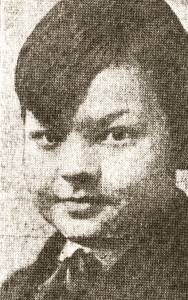 Orson Welles in 1926: “Cartoonist, Actor, Poet and only 10”
Orson Welles in 1926: “Cartoonist, Actor, Poet and only 10”
Welles briefly attended public school in Madison, Wisconsin, enrolled in the fourth grade. On September 15, 1926, he entered the Todd Seminary for Boys, an expensive independent school in Woodstock, Illinois, that his older brother, Richard Ives Welles, had attended ten years before but was expelled for misbehavior. At Todd School Welles came under the influence of Roger Hill, a teacher who was later Todd’s headmaster. Hill provided Welles with an ad hoc educational environment that proved invaluable to his creative experience, allowing Welles to concentrate on subjects that interested him. Welles performed and staged theatrical experiments and productions there.
“Todd provided Welles with many valuable experiences,” wrote critic Richard France. “He was able to explore and experiment in an atmosphere of acceptance and encouragement. In addition to a theater the school’s own radio station was at his disposal.” Welles’s first radio performance was on the Todd station, an adaptation of Sherlock Holmes that he also wrote.
On December 28, 1930, when Welles was 15, his father died at the age of 58, alone in a hotel in Chicago. His will left it to Orson to name his guardian. When Roger Hill declined, Welles chose Maurice Bernstein.
Following graduation from Todd in May 1931, Welles was awarded a scholarship to Harvard University, while his mentor Roger Hill advocated he attend Cornell College in Iowa.[22] Rather than enrolling, he chose travel. He studied for a few weeks at the Art Institute of Chicago with Boris Anisfeld, who encouraged him to pursue painting.
Welles would occasionally return to Woodstock, the place he eventually named when he was asked in a 1960 interview, “Where is home?” Welles replied, “I suppose it’s Woodstock, Illinois, if it’s anywhere. I went to school there for four years. If I try to think of a home, it’s that.”
Early Career (1931–1935)
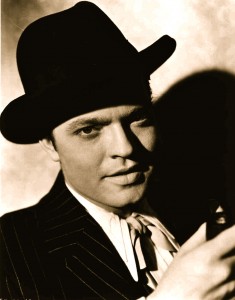 After his father’s death, Welles traveled to Europe using a small portion of his inheritance. Welles said that while on a walking and painting trip through Ireland, he strode into the Gate Theatre in Dublin and claimed he was a Broadway star. The manager of Gate, Hilton Edwards, later said he had not believed him but was impressed by his brashness and an impassioned quality in his audition. Welles made his stage debut at the Gate Theatre on October 13, 1931, appearing in Ashley Dukes’s adaptation of Jew Suss as Duke Karl Alexander of Württemberg. He performed small supporting roles in subsequent Gate productions, and he produced and designed productions of his own in Dublin. In March 1932 Welles performed in W. Somerset Maugham’s The Circle at Dublin’s Abbey Theatre and travelled to London to find additional work in the theatre. Unable to obtain a work permit, he returned to the U.S.
After his father’s death, Welles traveled to Europe using a small portion of his inheritance. Welles said that while on a walking and painting trip through Ireland, he strode into the Gate Theatre in Dublin and claimed he was a Broadway star. The manager of Gate, Hilton Edwards, later said he had not believed him but was impressed by his brashness and an impassioned quality in his audition. Welles made his stage debut at the Gate Theatre on October 13, 1931, appearing in Ashley Dukes’s adaptation of Jew Suss as Duke Karl Alexander of Württemberg. He performed small supporting roles in subsequent Gate productions, and he produced and designed productions of his own in Dublin. In March 1932 Welles performed in W. Somerset Maugham’s The Circle at Dublin’s Abbey Theatre and travelled to London to find additional work in the theatre. Unable to obtain a work permit, he returned to the U.S.
Welles found his fame ephemeral and turned to a writing project at Todd School that would become the immensely successful, first entitled Everybody’s Shakespeare and subsequently, The Mercury Shakespeare. Welles traveled to North Africa while working on thousands of illustrations for the Everybody’s Shakespeare series of educational books, a series that remained in print for decades.
In 1933, Roger and Hortense Hill invited Welles along to a party in Chicago, where Welles met Thornton Wilder. Wilder arranged for Welles to meet Alexander Woollcott in New York, in order that he be introduced to Katharine Cornell, who was assembling a repertory theatre company. Cornell’s husband, director Guthrie McClintic, immediately put Welles under contract and cast him in three plays. Romeo and Juliet, The Barretts of Wimpole Street and Candida toured in repertory for 36 weeks beginning in November 1933, with the first of more than 200 performances taking place in Buffalo, New York.
In 1934, Welles got his first job on radio — on The American School of the Air — through actor-director Paul Stewart, who introduced him to director Knowles Entrikin. That summer Welles staged a drama festival with the Todd School in Woodstock, Illinois, inviting Micheál Mac Liammóir and Hilton Edwards from Dublin’s Gate Theatre to appear along with New York stage luminaries in productions including Trilby, Hamlet, The Drunkard and Tsar Paul. At the old firehouse in Woodstock he also shot his first film, an eight-minute short titled The Hearts of Age.
A revised production of Katharine Cornell’s Romeo and Juliet opened December 20, 1934, at the Martin Beck Theatre in New York. The Broadway production brought the 19-year-old Welles (now playing Tybalt) to the notice of John Houseman, a theatrical producer who was casting the lead role in the debut production of Archibald MacLeish’s verse play, Panic.
On November 14, 1934, Welles married Chicago socialite and actress Virginia Nicolson (often misspelled “Nicholson”) in a civil ceremony in New York. To appease the Nicolsons, who were furious at the couple’s elopement, a formal ceremony took place December 23, 1934, at the New Jersey mansion of the bride’s godmother. Welles wore a cutaway borrowed from his friend George Macready.
By 1935 Welles was supplementing his earnings in the theater as a radio actor in Manhattan, working with many actors who would later form the core of his Mercury Theatre on programs including America’s Hour, Cavalcade of America, Columbia Workshop and The March of Time. “Within a year of his debut Welles could claim membership in that elite band of radio actors who commanded salaries second only to the highest paid movie stars,” wrote critic Richard France.
At age 22 Welles was Broadway’s youngest impresario — producing, directing and starring in an adaptation of Julius Caesar that broke all performance records for the play (1938).
Mercury Theatre
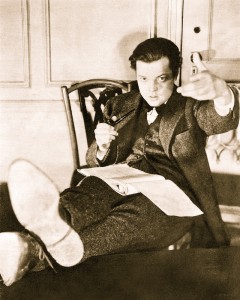 At age 22 Welles was Broadway’s youngest impresario — producing, directing and starring in an adaptation of Julius Caesar that broke all performance records for the play (1938)
At age 22 Welles was Broadway’s youngest impresario — producing, directing and starring in an adaptation of Julius Caesar that broke all performance records for the play (1938)
Breaking with the Federal Theatre Project in 1937, Welles and Houseman founded their own repertory company, which they called the Mercury Theatre. The name was inspired by the title of the iconoclastic magazine, The American Mercury.
Welles became executive producer and the repertory company eventually included actors such as Ray Collins, George Coulouris, Joseph Cotten, Dolores del Río, Agnes Moorehead, Erskine Sanford and Everett Sloane, all of whom worked for Welles for years.
The first Mercury Theatre stage production was a melodramatic edited version of William Shakespeare’s tragedy Julius Caesar, set in a contemporary frame of fascist Italy. Cinna, the Poet dies at the hands not of a mob but of a secret police force. According to Norman Lloyd, who played Cinna the Poet, “it stopped the show.”
Caesar opened November 11, 1937, followed by The Shoemaker’s Holiday (January 11, 1938), Heartbreak House (April 29, 1938) and Danton’s Death (November 5, 1938).
Radio (1936–1940) – Orson Welles radio credits
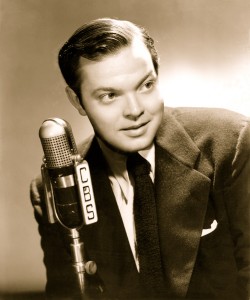 Simultaneously with his work in the theatre, Welles worked extensively in radio as an actor, writer, director and producer, often without credit. Between 1935 and 1937 he was earning as much as $2,000 a week, shuttling between radio studios at such a pace that he would arrive barely in time for a quick scan of his lines before he was on the air. While he was directing the Voodoo Macbeth Welles was dashing between Harlem and midtown Manhattan three times a day to meet his radio commitments.
Simultaneously with his work in the theatre, Welles worked extensively in radio as an actor, writer, director and producer, often without credit. Between 1935 and 1937 he was earning as much as $2,000 a week, shuttling between radio studios at such a pace that he would arrive barely in time for a quick scan of his lines before he was on the air. While he was directing the Voodoo Macbeth Welles was dashing between Harlem and midtown Manhattan three times a day to meet his radio commitments.
“What didn’t I do on the radio?” Welles reflected in February 1983:
Radio is what I love most of all. The wonderful excitement of what could happen in live radio, when everything that could go wrong did go wrong. I was making a couple of thousand a week, scampering in ambulances from studio to studio, and committing much of what I made to support the Mercury. I wouldn’t want to return to those frenetic 20-hour working day years, but I miss them because they are so irredeemably gone.
In addition to continuing as a repertory player on The March of Time, in the fall of 1936 Welles adapted and performed Hamlet in an early two-part episode of CBS Radio’s Columbia Workshop. His performance as the announcer in the series’ April 1937 presentation of Archibald MacLeish’s verse drama The Fall of the City was an important development in his radio career and made the 21-year-old Welles an overnight star.
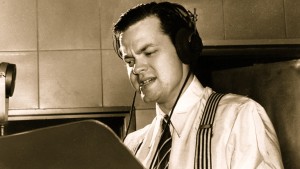 In July 1937, the Mutual Network gave Welles a seven-week series to adapt Les Misérables. It was his first job as a writer-director for radio, the radio debut of the Mercury Theatre, and one of Welles’s earliest and finest achievements. He invented the use of narration in radio.
In July 1937, the Mutual Network gave Welles a seven-week series to adapt Les Misérables. It was his first job as a writer-director for radio, the radio debut of the Mercury Theatre, and one of Welles’s earliest and finest achievements. He invented the use of narration in radio.
“By making himself the center of the storytelling process, Welles fostered the impression of self-adulation that was to haunt his career to his dying day,” wrote critic Andrew Sarris. “For the most part, however, Welles was singularly generous to the other members of his cast and inspired loyalty from them above and beyond the call of professionalism.”
That September, Mutual chose Welles to play Lamont Cranston, also known as The Shadow. He performed the role anonymously through mid-September 1938.
The Mercury Theatre on the Air
After the theatrical successes of the Mercury Theatre, CBS Radio invited Orson Welles to create a summer show for 13 weeks. The series began July 11, 1938, initially titled First Person Singular, with the formula that Welles would play the lead in each show. Some months later the show was called The Mercury Theatre on the Air. The weekly hour-long show presented radio plays based on classic literary works, with original music composed and conducted by Bernard Herrmann.
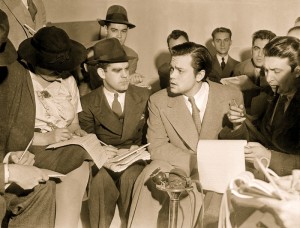 Welles at the press conference after “The War of the Worlds” broadcast (October 31, 1938)
Welles at the press conference after “The War of the Worlds” broadcast (October 31, 1938)
“The War of the Worlds”
The Mercury Theatre’s radio adaptation of The War of the Worlds by H. G. Wells October 30, 1938, brought Welles instant fame. The combination of the news bulletin form of the performance with the between-breaks dial spinning habits of listeners was later reported to have created widespread confusion among listeners who failed to hear the introduction, although the extent of this confusion has come into question. Panic was reportedly spread among listeners who believed the fictional news reports of a Martian invasion. The myth of the result created by the combination was reported as fact around the world and disparagingly mentioned by Adolf Hitler in a public speech some months later.
Welles’s growing fame drew Hollywood offers, lures that the independent-minded Welles resisted at first. The Mercury Theatre on the Air, which had been a sustaining show (without sponsorship) was picked up by Campbell Soup and renamed The Campbell Playhouse.

